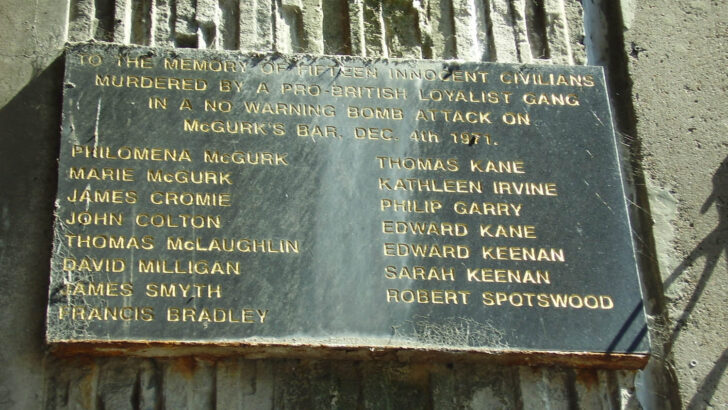The Sorrow and the Loss: The Tragic Shadow Cast by the Troubles on the Lives of Women,
by Martin Dillon
(Merrion Press, €19.99 / £15.50).
This book provides an account of the grief, sorrow, hurt and tragedy visited on women by the so-called ‘Troubles’ in Northern Ireland.
Reading it brought to mind those scenes in Sean O’Casey’s play The Plough and the Stars about the ‘Troubles’ of the past which we have been commemoration. The women in his work all too often were left to bear the emotional and tragic burdens created by the men around them. All too often this seems to be the case in history, not just here in Ireland, but everywhere.
In pursuit of his theme Martin Dillon presents a series of personal testimonies. Carol Rice completed her nursing studies in 1988 and took a job in a London hospital. She married Simon Ware, who was a soldier in the Coldstream Guards Regiment in 1990. With his battalion he was deployed to serve in Northern Ireland in 1991. While on patrol he was killed by a wayside bomb. The death of Carol’s husband cast a dark shadow over the rest of her life. She never ceased to be upset that no one has ever had to face justice for killing her husband.
Tracy Doak came from an RUC family. Her father, Beattie, was an RUC constable for decades and her brother, Allister, was also a member of the force. She realised the ambition she had from childhood when she joined the RUC in 1982. Just three years later, while escorting a Brinks-Mat van carrying foreign currency near the border between Northern and Southern Ireland, she and her colleagues were blown up by a 1,000 lb bomb hidden in a trailer parked at the side of the road. The spectre of Tracy’s remains scattered across a field continues to haunt her parents. When asked about the loss and pain she continues to suffer, Jean, Tracy’s mother, replied: ‘It is the last thing at night and the first thing in the morning. I wear it like a coat’.
Serena was the daughter of David Graham. He worked in a cement factory and spent most of his free time gardening and growing roses. He was also an active member of his local Orange Lodge. He joined the UDR, which replaced the B-Specials, in 1972. It was his contribution to defending his country and it supplemented his weekly cement-factory wage packet. As he arrived at his work-place in March 1977 he was fatally wounded by two IRA ‘gunmen’. Serena and her mother’s loss and sorrow was accentuated when they later learned the identity of one of the killers who was never to stand trial for his crime.
The IRA regarded those who sat on the bench in Northern Ireland as the enemy. They assassinated Judge William Doyle and Resident Magistrate William Staunton in 1973. A year later as Judge Tom Travers and his family exited St Brigid’s Church in Belfast they were attacked. Tom’s daughter, Mary, was shot dead and Tom was gravely wounded but survived. He identified his would-be killer: Joe (The Hawk) Haughey.
At his trial, despite the evidence to the contrary, Haughey was declared to be innocent of the crime. Martin Dillon notes that besides being a notorious IRA killer he was also at the time a British military agent (‘asset’). This perversion of justice added to the grief of the Travers family.
Then there were the perpetrators of indiscriminate slaughter. Stevie ‘Top Gun’ McKeag was typical of loyalist sectarian killers. He was reputed to have murdered dozens of Catholics, each of whom lost their lives simply because they happened to be Catholics and were easy targets.
The bombing of McGurk’s Bar on Belfast’s North Queen Street in the New Lodge area was one of the earliest major atrocities in the ‘Troubles’. The Bar was so-called as the McGurk family resided in a flat upstairs. A member of the UVF placed a no-warning bomb at the door-way of the building.
In the resultant explosion most of the Bar’s patrons, including the McGurk family, were buried under the rubble. Fourteen were killed and many others suffered serious injuries. The statement issued by the British authorities and the RUC plumbed the debts of cynicism. According to Mary Kane, whose father did not return home from McGurk’s Bar after his after-work drink, the manner in which this tragic event was handled by officials in the North only increased the sense of loss and grief felt by the bereaved.
The McGurk’s Bar atrocity was not the end of indiscriminate mass killings. The highest casualty list of the ‘Troubles’ occurred on May 17 1974 when loyalists planted four no-warning bombs in the Republic. The four bombs killed thirty-four people, most of them women, and injured 258 others.
Apart from providing the important perspective on how women were affected by the ‘Troubles’, this very informative book reveals the remarkable extent to which the paramilitaries on both sides of the conflict were riddled with informers: RUC Special Branch ‘assets’, M15 ‘assets’ and M16 ‘assets’.
But that too, as other writers aside from Sean O’Casey have reminded us, is an old tale of Irish revolutionaries and their ways going back to Captain Le Caron in the days of the Fenians, a never changing aspect of history.


 The memorial to those killed in the bombing of McGurk’s Bar.
The memorial to those killed in the bombing of McGurk’s Bar. 